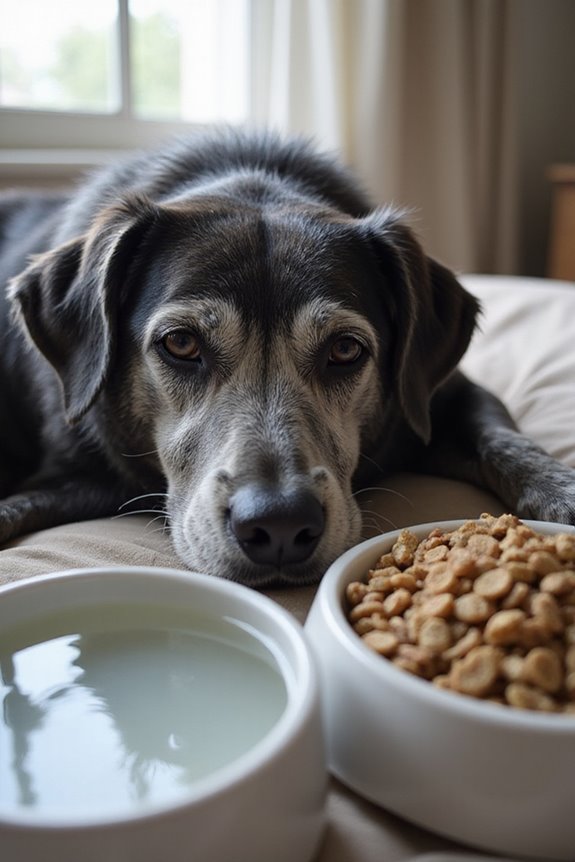It’s vital to contemplate quality of life for your senior dog when you notice changes in their physical or emotional behavior. Signs like decreased interest in toys, social withdrawal, or changes in mobility should prompt assessment. Regular evaluations for pain levels, mobility, and daily activity can indicate declining well-being. Additionally, monitoring appetite and hydration is fundamental. Understanding these factors helps guarantee your dog’s comfort and happiness. More insights on this topic can enhance your approach to care.
Key Takeaways
- Conduct quality of life assessments regularly to identify any changes in mobility, pain levels, and emotional well-being in senior dogs.
- Notice behavioral shifts, such as loss of interest in activities or increased clinginess, indicating a decline in quality of life.
- Monitor mobility, including changes in gait and activity levels; decreased independence suggests it may be time to assess quality of life.
- Utilize pain scoring systems to evaluate discomfort and its impact on daily activities; significant pain may warrant reconsideration of a dog’s quality of life.
- Engage with a veterinarian to discuss observations; collaborating on healthcare plans is crucial for managing a senior dog’s quality of life.
Understanding the Importance of Quality of Life Assessments
Evaluating the quality of life (QOL) for senior dogs is essential because it enables us to identify and address their needs effectively. Quality assessments provide structured, quantifiable insights into a dog’s well-being, particularly concerning pain and emotional well-being. For instance, the widely recommended HHHHHMM scale allows for an objective evaluation of seven key areas, including mobility and happiness. Regular assessments enable early identification of distress, guiding necessary interventions. Tools like printable QOL scales and online calculators facilitate tracking a dog’s condition over time. By monitoring factors such as appetite, hydration, and mental state, we can guarantee our beloved companions maintain a comfortable, fulfilling life, reinforcing our commitment to their happiness and health as they age.
Recognizing Signs of Decline in Senior Dogs

Recognizing the signs of decline in senior dogs is essential for ensuring their well-being and addressing their changing needs. As our beloved companions age, we may notice several behavioral shifts indicative of their condition:
- Loss of Interest: They might no longer engage with favorite toys, signaling a potential cognitive dysfunction.
- Social Withdrawal: Decreased responsiveness to affection or companions can reflect emotional changes.
- Increased Clinginess or Aggression: These shifts may emerge, warranting a thoughtful approach, including consulting a veterinarian.
- Cognitive Decline: Disorientation and forgetfulness can disrupt familiar routines, amplifying anxiety.
Being attuned to these changes allows us to provide the comfort and support that our senior dogs need, ensuring their final years are as joyful as possible.
Evaluating Mobility and Independence

How do we determine if our senior dogs maintain their mobility and independence? To effectively evaluate mobility, we can conduct mobility assessments that assess movement patterns and functional independence. Observing how our dogs stand, walk, and shift between positions provides insights into their functional abilities.
Key indicators include:
- Declining activity levels, such as increased resting or reluctance to climb stairs.
- Changes in gait speed and stride length.
- Maintaining balance while moving, vital for preventing falls.
We should regularly check for signs of stiffness or discomfort and guarantee their ability to navigate their home without assistance reflects their independence. Regular use of joint supplements can also support their mobility and comfort. Early detection of mobility decline allows us to adapt their environment and seek veterinary advice for maintaining their quality of life.
Assessing Pain and Discomfort Levels

Evaluating pain and discomfort levels in senior dogs is essential for ensuring their overall quality of life, especially after considering their mobility and independence. One effective approach is using pain scoring systems like the Canine Brief Pain Inventory. As an owner, your involvement is critical; you can assess your dog’s pain severity by rating their discomfort from 0 to 10.
Pay attention to changes in daily activities that your dog enjoys, such as walking or climbing stairs. Additionally, consider their overall quality of life by scoring it from 0 to 5. This thorough owner assessment complements veterinary evaluations, ensuring a fuller understanding of your dog’s pain levels and guiding appropriate interventions for their wellbeing.
Understanding Changes in Appetite and Hydration

As dogs age, changes in their appetite and hydration can indicate underlying health issues that warrant attention. I’ve noticed that appetite changes can stem from a decreased sense of taste and smell, coupled with a slower metabolism in senior dogs. If my dog shows a significant decrease in appetite beyond the normal mild reduction, I consult a vet. It’s also vital to take into account hydration challenges; the aging body struggles with water balance, and not drinking enough increases dehydration risk. Ensuring fresh water is always accessible is essential. If my dog refuses to drink, I seek veterinary advice. Maintaining proper nutrition and hydration helps support overall health, aiding in kidney function and digestion, ultimately enhancing their quality of life.
Monitoring Social Behavior and Interaction
Monitoring changes in social behavior and interaction in senior dogs is essential for maintaining their quality of life. It’s alarming that, by ages 15-16, up to 68% of dogs show impairments in social behavior. As an owner, I must carefully observe my dog’s interaction patterns and respond to subtle shifts, as these changes could indicate cognitive decline or underlying health issues.
Key signs to monitor include:
- Decreased interest in play or interaction
- Increased guarding behaviors over space or resources
- Withdrawal from familiar humans or pets
- Fluctuating emotional stability or irritability during social encounters
Keeping a record of these observations can facilitate discussions with my vet, allowing for tailored strategies to guarantee my older dog maintains healthy social interactions.
Utilizing Quality of Life Scales for Decision Making
Utilizing Quality of Life (QoL) scales offers dog owners and veterinarians a structured approach to assess the well-being of senior dogs, especially when faced with difficult decisions regarding health interventions or end-of-life care. These QoL metrics focus on essential aspects of a dog’s physical and emotional well-being, including:
- Pain levels and mobility
- Energy and ability to perform daily activities
- Appetite and hydration
- Emotional state, including anxiety or signs of depression
- Overall happiness and enthusiasm for interaction
Considering Caretaker Fatigue and Family Needs
Caring for a senior dog can be an emotionally and physically demanding endeavor, particularly when caretaker fatigue sets in. It’s vital to acknowledge the emotional toll this fatigue takes, as feelings of frustration, guilt, and stress can compound the challenges of caring for our beloved pets.
Family dynamics also play an important role. As family members become involved, we must navigate resource allocation and emotional attachments that complicate decisions. Balancing the needs of our pets with those of the family can lead to conflicts, intensifying stress.
To effectively manage caretaker fatigue, consider:
- Establishing clear communication within the family.
- Utilizing respite care for temporary relief.
- Creating support networks to ease burdens.
Recognizing these elements can greatly improve both caregiver and family well-being.
The Role of Veterinary Guidance in End-of-Life Decisions
When guiding end-of-life decisions for senior dogs, the expertise of veterinary professionals is indispensable, as they provide the necessary guidance to help owners make informed choices. Veterinary advice is essential for evaluating quality of life, focusing on pain levels, mobility, and overall happiness. This objective evaluation allows us to detect signs of decline early, ensuring compassionate communication regarding the options available.
Veterinarians prioritize pain management and may recommend palliative or hospice care when curative treatments are no longer viable. They offer emotional support to navigate these difficult decisions and discuss realistic outcomes. Their guidance reduces stress and empowers us, the pet owners, to make timely and thoughtful choices about our beloved companions’ end-of-life journey.
Exploring Support Options for Senior Dogs
Exploring support options for senior dogs is vital, as their unique health needs demand a thorough approach. To guarantee senior wellness, I recommend implementing extensive healthcare plans tailored to address chronic conditions and lifestyle specifics. Regular wellness exams, ideally quarterly, facilitate constant health monitoring.
Adapting your home environment can greatly enhance your dog’s comfort; consider non-slip surfaces and cozy resting spots. Interactive toys can stimulate cognitive functions, while specialized diets are important for managing metabolic changes. Including high-quality protein sources in their diet is essential for senior dog’s health, ensuring they receive the nutrients they need for vitality.
Utilizing caregiver resources like educational materials and support networks can empower you, offering relief and guidance in steering your senior dog’s care. Finally, don’t hesitate to communicate openly with your veterinarian about any changes you observe, ensuring proactive management of your dog’s unique needs.
Frequently Asked Questions
How Can I Create a Custom Quality of Life Scale for My Dog?
Creating a custom scale for my dog’s assessment feels like crafting a fine wine— I’m balancing comfort and chaos. Why not rate pain, playtime, and the joy of belly rubs, right? Let’s do this together!
What Are Some Signs My Dog Is Experiencing Emotional Distress?
I’ve noticed my dog’s behavioral changes lately; he’s been more vocal and shows signs of distress. It breaks my heart. If you see such shifts, it’s essential to explore what might be bothering them.
How Can I Involve My Family in Quality of Life Decisions?
Like threads woven together, family meetings bring us closer. I’m involving everyone by sharing responsibilities, discussing our dog’s needs together, and creating a supportive space where we openly express our feelings and find collective understanding.
What Legal Considerations Should I Be Aware of Regarding Pet Euthanasia?
I’ve learned that understanding pet ownership laws and euthanasia guidelines is essential. Consulting with a vet guarantees you follow legal procedures, helping me make the best, most loving decision for my furry friend during tough times.
How Do I Cope With Guilt After Making End-Of-Life Decisions for My Pet?
Coping with guilt after my pet’s end-of-life decision was tough. I focused on guilt management and emotional healing, reminding myself it was a compassionate choice. Connecting with others helped me feel less alone in my grief.

